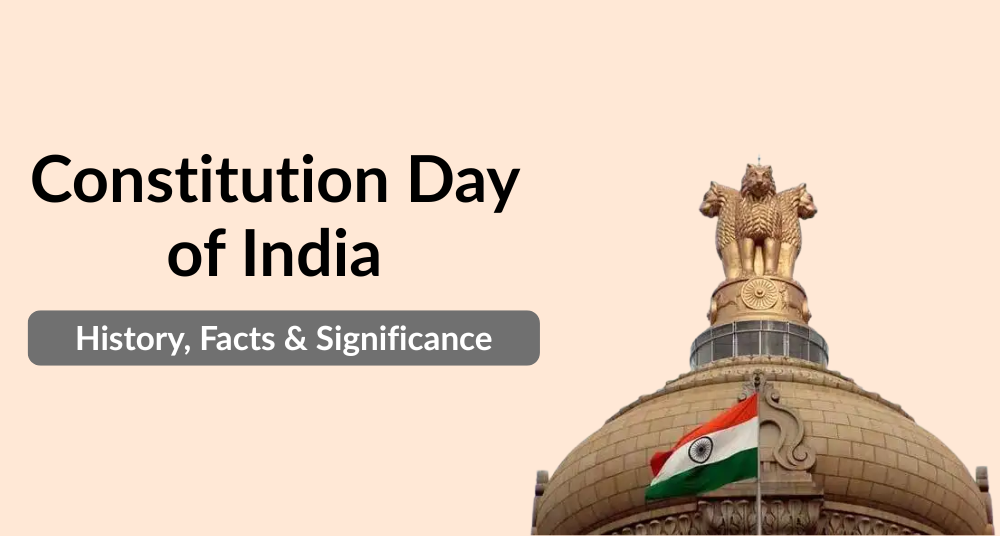Constitution Day of India, also known as Samvidhan Divas, is celebrated every year on 26 November to honor the adoption of the Indian Constitution. This day is dedicated to remembering the unmatched contributions of Dr. B.R. Ambedkar, the Chairman of the Drafting Committee, and all members of the Constituent Assembly who shaped India’s legal, social, political, and economic framework. Constitution Day is not just a ceremonial observance—it is a moment to reflect upon the principles that define our democracy: justice, liberty, equality, and fraternity.
First celebrated in 2015, Constitution Day has gained national importance as schools, colleges, government institutions, and citizens participate in reading the Preamble, discussing constitutional rights, and understanding the duties that bind us together. In a society as diverse as India, the Constitution plays a crucial role in unifying over 1.4 billion people. This article explores the history, significance, features, key facts, and legacy of the Indian Constitution in detail.
History of the Constitution Day of India
Formation of the Constituent Assembly
The Constituent Assembly of India was formed in 1946 under the Cabinet Mission Plan. It consisted of 389 members, including representatives from British India and princely states.
Key highlights:
- First meeting held on 9 December 1946
- Dr. Rajendra Prasad elected as President of the Constituent Assembly
- Dr. B.R. Ambedkar appointed as Chairman of the Drafting Committee on 29 August 1947
- Total of 11 sessions and 165 days spent in discussions and debates
Adoption of the Constitution (26 November 1949)
After nearly 2 years, 11 months, and 18 days, the Constituent Assembly completed the drafting of the Constitution. On 26 November 1949, it was adopted, and two important provisions—citizenship and elections—came into immediate effect.
Enforcement of the Constitution (26 January 1950)
The Constitution came into full effect on 26 January 1950, marking the birth of the Republic of India. The date was chosen to honor the 1930 Purna Swaraj Declaration, making 26 January historically symbolic.
Beginning of Constitution Day (2015)
Prime Minister Narendra Modi declared 26 November as Constitution Day in 2015 to commemorate Dr. Ambedkar’s 125th birth anniversary and to promote constitutional awareness among citizens.
Significance of Constitution Day
Honoring the Founding Fathers
Constitution Day pays tribute to:
- Dr. B.R. Ambedkar
- Dr. Rajendra Prasad
- Jawaharlal Nehru
- Sardar Vallabhbhai Patel
- All members of the Constituent Assembly
Their commitment helped shape India’s democratic foundation.
Celebrating India’s Democratic Identity
The Constitution is the supreme law that defines:
- Rights of citizens
- Role of government
- Administrative structure
- Duties and values
This day reminds us to protect democratic principles.
Promoting Constitutional Literacy
The government encourages:
- Reading the Preamble
- Conducting debates and quizzes
- Organizing awareness programs
The goal is to ensure every citizen understands constitutional rights and duties.
Strengthening National Unity
India’s diversity in language, culture, and religion is held together by constitutional ideals of equality and fraternity.
Encouraging Citizen Participation
Constitution Day inspires people to:
- Vote responsibly
- Respect fundamental duties
- Promote harmony and tolerance
Key Features of the Indian Constitution
The Indian Constitution is widely regarded as one of the most comprehensive constitutions in the world.
Lengthiest Written Constitution
With over 448 Articles, 12 Schedules, and numerous amendments, it is the longest written constitution globally.
Blend of Rigidity and Flexibility
While some parts require extensive parliamentary support to amend, others can be changed by a simple majority.
Parliamentary System
India follows the Westminster parliamentary model, ensuring a responsible government with clear separation of powers.
Federal System with Unitary Bias
It combines:
- Federalism (Centre + States)
- Strong unitary features during national emergencies
Secular State
The Constitution ensures:
- No state religion
- Equal respect for all faiths
Fundamental Rights
Part III guarantees rights such as:
- Right to equality
- Right to freedom
- Right against exploitation
- Right to freedom of religion
- Cultural & educational rights
- Right to constitutional remedies
Directive Principles
These principles guide the government in policymaking, focusing on:
- Welfare
- Social justice
- Economic upliftment
Fundamental Duties
Added in 1976, these duties encourage:
- Patriotism
- Environmental protection
- Respect for national symbols
Why Constitution Day Matters Today?
Rising Need for Legal Awareness
Many citizens still lack awareness of their constitutional rights.
Protection of Democratic Institutions
The Constitution safeguards:
- Judiciary
- Legislature
- Executive
This ensures checks and balances.
Social Harmony
In a diverse country, constitutional values help prevent discrimination and promote unity.
Empowering the Youth
Schools celebrate Constitution Day by:
- Reading the Preamble
- Learning about democracy
- Organizing debates
This helps build responsible future citizens.
Preamble of India — The Soul of the Constitution
The Preamble reflects the ultimate goals of the nation:
- Sovereign
- Socialist
- Secular
- Democratic Republic
It ensures:
- Justice (Social, Economic, Political)
- Liberty (Thought, Expression, Belief, Faith, Worship)
- Equality (Status & Opportunity)
- Fraternity (Unity & Integrity of Nation)
Interesting Facts About the Indian Constitution
- Original Constitution had 395 Articles and 8 schedules.
- Handwritten in Hindi and English, not typed.
- Calligraphed by Prem Behari Narain Raizada.
- Decorated by artists from Santiniketan.
- Took 2 years, 11 months, 18 days to draft.
- The Constitution is kept in helium-filled cases in the Parliament Library.
- Indian Constitution borrowed features from many nations:
- Britain → Parliamentary system
- USA → Fundamental Rights
- Ireland → Directive Principles
- Canada → Federal structure
- France → Liberty, equality, fraternity
How Constitution Day Is Celebrated Across India?
Reading of the Preamble
Schools, colleges, government offices read the Preamble together.
Debates & Quizzes
Competitions are held on:
- Indian Constitution
- Constitutional rights
- Democracy and governance
Address by the President or Prime Minister
National speeches emphasize:
- Dr. Ambedkar’s legacy
- Role of the Constitution in modern India
Awareness Programs
NGOs, legal groups, colleges conduct awareness campaigns about:
- Fundamental rights
- Fundamental duties
- Constitutional values
Digital Celebrations
Government portals host:
- Online quizzes
- E-pledges
- Constitution reading challenges
Role of Dr. B.R. Ambedkar in Drafting the Constitution
Dr. Ambedkar is often called the “Father of the Indian Constitution”.
His contributions include:
- Ensuring social justice
- Promoting equality before law
- Protecting minority rights
- Creating safeguards against discrimination
His vision continues to guide India today.
Impact of the Constitution on Modern India
Strengthening Democracy
India is one of the world’s largest and stable democracies due to its robust constitutional framework.
Social Reforms
Laws have been enacted to:
- Abolish untouchability
- Promote education
- Protect women and children
Economic Development
The Constitution lays the foundation for:
- Fair taxation
- Balanced development
- Industrial regulation
Preserving Unity
Despite cultural, linguistic, and religious diversity, India remains united through constitutional values.
Conclusion
Constitution Day of India is more than a celebration—it is a reminder of the vision that built modern India. The Constitution is not merely a legal document but a guide that reflects the dreams, struggles, and aspirations of the nation. It ensures justice, liberty, equality, and fraternity for all citizens while providing the framework for democratic governance and social harmony.
As citizens, understanding the Constitution is not just a duty but an essential responsibility. On every Constitution Day, we pay homage to Dr. Ambedkar and all founding members who gave India one of the world’s most progressive constitutions.
Frequently Asked Questions (FAQs)
What is Constitution Day of India?
Constitution Day, or Samvidhan Divas, is celebrated on 26 November to mark the adoption of the Indian Constitution in 1949.
Why is Constitution Day celebrated on 26 November?
Because the Constituent Assembly adopted the Constitution on this date, even though it came into effect later on 26 January 1950.
Who is known as the Father of the Indian Constitution?
Dr. B.R. Ambedkar, Chairman of the Drafting Committee, is widely regarded as the Father of the Indian Constitution.
When was Constitution Day first celebrated?
It was first officially celebrated in 2015, declared by the Government of India in honor of Ambedkar’s 125th birth anniversary.
Is Constitution Day a national holiday?
No, Constitution Day is not a public holiday. Schools and government institutions observe it with activities and programs.
What activities are held on Constitution Day?
Activities include reading the Preamble, debates, quizzes, essay competitions, and awareness programs about rights and duties.
How long did it take to draft the Indian Constitution?
It took 2 years, 11 months, and 18 days for the Constituent Assembly to complete the drafting process.
Who was the President of the Constituent Assembly?
Dr. Rajendra Prasad served as the President of the Constituent Assembly.
What are the key values mentioned in the Preamble?
The Preamble reflects Justice, Liberty, Equality, and Fraternity, defining India as a Sovereign, Socialist, Secular, Democratic Republic.
Why is Constitution Day important today?
It encourages constitutional awareness, strengthens democratic values, and reminds citizens of their rights and fundamental duties.
Related Blog: Aadhaar Card Update Guide






What do you think?
It is nice to know your opinion. Leave a comment.